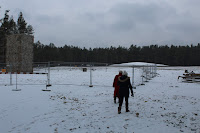As these excavations have been re-buried I have included an aerial photograph produced as a result of the archaeological work in 2014 led by Yoram Haimi that shows where the foundations to several buildings had been discovered, thought to be gas chambers, with the crematorium laying somewhere behind.
The area around the Polish Monument was cordoned off by large metal fences on both of my visits.
During my first trip to Sobibor back in January 2016 the area that had been excavated in 2014 where building foundations that are thought to represent the gas chambers were covered in snow.
 |
| The area cordoned off by the security fence with the Sobibór extermination camp memorial in the distance |
 |
| Polish Monument surrounded by the security fence, Jan 2016. |
The metal fences contain an area of loosely scattered sandy soil that covers the area where excavations had been carried out in 2014. Although it was covered in snow I took several photographs of the area contained by the security fences.
 |
| Area in front of the Polish Memorial thought to contain the foundations of the gas chambers. |
 |
| Area to the left of the Polish Memorial thought to contain the foundations with the crematorium in the distance |
 |
| Area directly in front of the Polish Memorial thought to contain the foundations of the gas chambers |
 |
| Area to the right of the Polish Memorial. The gap in the trees in the distance leads back to the railway amp |
 |
| Area in front of the Polish Memorial taken next to the memorial. |
Returning in October I managed to get some photographs of the area contained within the security fencing without the snow.



There is decent in the camp amongst the experts concerning the significance of the foundations found in 2014. Apparently it has been pointed out that the foundations unearthed by the excavations and dimensions revealed contradict all earlier eye witness reports from survivors and former guards. Apparently the shape of the walls and the building do not match the buildings described by eye witnesses. While the foundations uncovered in 2014 showed several irregular shaped and different sized rooms, the eye witness accounts talk about rooms of the same size.
Historian Peter Winters pointed out that there was no evidence that the foundations uncovered were actually those of the gas chambers. Therefore to finish this section which is one of the most important as it represents 'the gas chambers location', the existence of which have become synomonous across the various extermination camps of Operation Reinhard, I note that the foundations unearthed are 'thought' to be those of gas chambers in Lager III of the Sobibor extermination camp and I am sure the arguments will continue.
Personally I feel that these people are transfixed on finding any solid foundations that they can claim are gas chambers without, as far as I can see, any firm evidence.











